Adriana van Tilburg shows that bloodline research is not always a matter of numbers…
The quality of a mare line cannot be judged only by the number of representatives of the line. The biggest Stamm we know in Holstein is 776. Against that there are the mare lines which are very small, maybe less than 1 % the size of the mighty 776. To most breeders they are not well known, but one that will live forever in my heart is Stamm 2294.
The mare lines, or Stamm, are of particular importance in the Holsteiner studbook. The first studbook published in 1897 was compiled by Georg Ahsbahs who traced back the mare families to the beginning of the 19th century, assigning Stamm numbers to each of them. This system is still used today
I spent some years of my childhood daily visiting a farm with mainly Dutch Warmbloods. One mare was special to me, a black mare with the name Josiane (Tin Rocco – Neigung x Laertes, bred by Heike Mohr). We are talking about more than 25 years ago. I had no knowledge about bloodlines whatsoever.
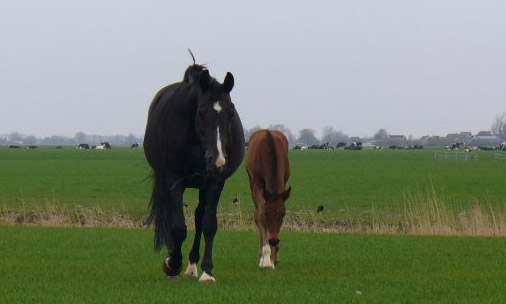
Our paths crossed again in 2000. This wonderful mare had lived through some horrible years – as a five-year-old she spent 120 days in the Dutch university clinic – hovering for 10 days between life and death. When she emerged from the clinic she suffered again from the ignorance of the people around her. They made her ‘dangerous’, she was being ridden even though the clinic sent a letter to the owner stating she could not be ridden anymore, ever!
In 2000 I started to take care of her and I did not know her history at the time. She gave birth to the most amazing filly by Flemmingh (Lacapo), Tharesia. I could brush Josiane once a week, if I tried to do it more often she would make very clear with her body language that I should leave her alone. Her big soft eye made me want to stay with her. When Tharesia was weaned, Josiane wanted attention, that was the start of our journey…
I found out that her brand was different from the other Warmbloods and I researched that brand. That is how I learned about Holsteiners. I started researching on the internet about the history of the Holsteiner horse and I got in contact with Karen Reid who was from the USA. She has imported semen from the Holsteiner Verband for more than 20 years and she knew where I should start with my journey researching Josiane and her bloodlines.
In 2003 I was invited by Karen to visit Holstein, to go to the Holsteiner stallion approvals and she said that afterwards I should stay in Haselau, at the ‘Haselauer Landhaus’ owned by the family, Lienau who have run the hotel, and the stallion station that was attached, for fourteen generations!
At that moment I did not know that the mother of Josiane, and her half sister were bred at the Haselau stallion station. I learned more and more about Josiane’s Stamm and found out that it was very small. In 2004 I bought a jacket, and had Stamm 2294 put on the back. Nobody had ever heard of that Stamm – and Josiane is the reason I am so passionate about breeding.
Through the years Josiane and I had the most amazing bond. She is the reason I started a very interesting journey and that I had the privilege to work for Jos Lansink, Meredith Michaels Beerbaum and other fantastic stables. Due to reasons out of my control I had to stop taking care of her, but she never left my heart and every time I could visit her, even when I had to do it secretly, I did. She died in 2012 at the age of 21 and a few months later there was a stallion presented at the Holsteiner stallion approvals from 2294. It was the first time since I had been coming to Holstein that there was a stallion from this Stamm at the Holsteiner stallion approval: Dinken (Diarado – Inken I x Cassini I, bred by Theo Molenaers!
Work horses
Dinken may have been the first stallion from this Stamm that I saw approved, but he was not the first ever, my thirst for knowledge took me back to Holstein’s historic marshes…
The Stamm was founded around 1893 in the district of Steinburg and the first registered mare was born in that year – a chestnut mare by Imsel. The first approved stallion from this line is born in 1917, Johann (Ambos – Betta x Ohm Paul, bred by Johannes Franzenburg). Betta is also grandmother to a mare born in 1926 Carena (Genever – Oresta x Landgraf), and it is with Carena that our journey begins.
Carena was bred by Heinrich Feil from Trennenworther Altendeich in the region Dithmarschen. With this mare, Hans Dwenger from Nutteln started his breeding with Stamm 2294. He paired Carena with Neidhard and Makler I. It is difficult to get more information about specific mares. Not only because it is a long time ago, but also because the mares were never called by their real names, they all had nicknames.
Thanks to the granddaughter of the breeder and her son, I received documents from before World War II, during World War II and shortly after World War II. In 1941 Carena’s daughter, the three year old, Wyk (Neidhard) earned a document that stated that she was a very valuable mare. This was also a document that stated the breeder could keep the mare for work and breeding instead of being taken by the German army for the war. At that time the premium system was also different. Nowadays only three-year-old mares can earn a state premium, but on that paper are stamps from Wyk as a foal, yearling and two year old being awarded as state premium.
Another daughter of Carena, Baerlein by Makler I, had, according to the relatives of Hans Dwenger, a cannon bone that measured 20,8 cm and for that time – before the Holsteiner breed was crossed with Thoroughbreds – it was more normal to have a size from 23 cm. Nowadays we have a sizes from around 20 cm upwards. This mare’s name was officially Röslein, but due a typo it became Baerlein.
According to the relatives of Hans Dwenger, the Makler I offspring didn’t have such good movement and according to the stallion book from Dr. Dietrich Rossow (written in 1954) Makler I‘s offspring could have their own special character. The good points were that the mares were excellent broodmares and he matched really well with Neidhard mares. Neidhard produced horses with good movement and the offspring were known for being very healthy. Röslein’s daughter Hildchen (Gasparone) was for a while in the village Aukrug, there she produced as a 17-year-old, the filly Carmelita (Cobalt) born in 1966. Cobalt only covered for three years until the Holsteiner Verband took his status away as an approved stallion. He produced only 30 mares. Now 50 years later, experts say that his offspring weren’t so bad at all. Some Cobalt mares are standing at the beginning of a branch with a lot of performance, like Stamm 3389 (Cassini I/II and Clarimo). Carmelita is the foundation mare for the two branches of Stamm 2294. She was purchased by Werner Krohn from Pinneberg.
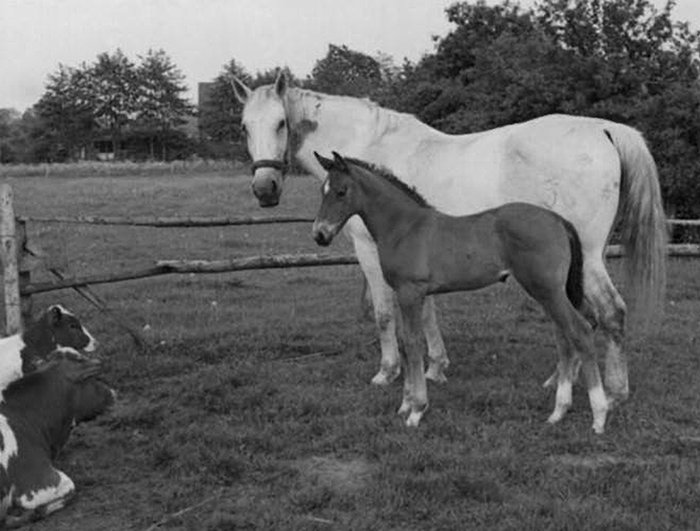
Carmelita as a foal – photo private collection
Carmelita
Werner Krohn brought Carmelita to the Haselauer stallion station to be covered. From several breeders out of the region Pinneberg, I learned that Werner Krohn was very proud of Carmelita. Also this mare was known for having her own opinion.
The first daughter out of Carmelita was Herietta (Waterman), born in 1971. Waterman (Water Serpent xx – Ilda x Fanal, Stamm 357, bred by Gisela Holstein) stood two years in Haselau at the stallion station. Werner Krohn went also with Herietta to Haselau. Her daughter Maibirke (Marlon xx) was born in 1975. Marlon xx (Tamerlane xx – Maralinni xx x Fairford xx, bred by H. Kerr) stood only one year in Haselau. He was a very good Thoroughbred and had the ability to give his offspring extra movement. His offspring excelled in all disciplines.
The second daughter of Carmelita to go on to be a brood mare, is Neigung (Laertes). According to Joachim Ahsbahs (breeder of Quintero and who used to be a member of the Holsteiner stallion approvals committee) Neigung was the most beautiful daughter of Laertes.
Laertes (Ladykiller xx – Diastolchen x Loretto, Stamm 242, bred by Oskar Marckmann) could have been just as famous as Landgraf I (Ladykiller xx – Warthburg x Aldato, Stamm 275, bred by Graf von Kielmansegg) and Lord (Ladykiller – Viola x Cottage Son xx, Stamm 1298, bred by Heinrich Schuldt), but his job was to cover mares who were difficult to get in foal. He stood during the summer in the field with many mares and during the winter he had to recover from his hard work. When Laertes came back in to the stable from the summer season he was sleeping a lot. The quality of mares that he had to cover was very mixed.
In 2003 I received a letter from the new owner of Neigung, Heike Mohr. She writes: “I got Neigung as a 10-year-old riding horse from my husband for my birthday. We called her Carmen because she had a lot of temperament and could be difficult. She had very good movement and could have become a dressage horse. You had to brush and tack her up in the stable, going with her to the stallion station was a huge adventure since she didn’t like to be transported. With a lot of patience and empathy we became a combination, I was only a hobby rider and we have done some really nice pleasure riding. She had a foal when she was a four-year-old and we thought that the Stamm was interesting so we decided to bring her to stallion station Maas J Hell to let her be covered by Tin Rocco (Tin Rod xx – Bajade x Roman, Stamm 2165, bred by Hermann Blohm).”
“In 1991 her filly was born, she was very kind, you could handle her easily and she was very noble. We knew that it would be a risk to cover Carmen with Tin Rocco because of the character, but I liked everything else about him. In 1995 she produced a colt by Alasca (Ahorn Z – Roemerin x Calypso II, Stamm 5739, bred by Annegret Tammling) I sold him when he was 6 months old. The new owner wanted to take him to the approvals, there he did not show enough scope and was gelded. We didn’t manage to get Carmen in foal again and she enjoyed her life at pasture. We had to put her down when she was 26 because of aging problems.”
Neigung’s Tin Rocco filly born in 1991 was Josiane. First she was sold as a weaned foal to Maas J Hell, he sold her to VDL Stud and so she ended up with her owner J. Kroodsma in Dokkum. Unfortunately a lot of her offspring are off the radar. She has a son, Whispering the Wild (Flemmingh), who jumped at 1.40 level in Singapore. His full sister Tharesia competed at advanced level dressage. Neigung’s Alasca son, Aquavit, would grow up as a wonderful jumping horse with amateur rider Frauke Haldy, they competed at 1.40 level. When he was 18 years old, he was still jumping in low classes.
Neigung’s first daughter was Scarlett (Calando I) who produced L-Rovinia (Ramiro) who is now a broodmare in Poland. In Germany L-Rovinia produced Lara J (Landstreicher), she was qualified for the Bundeschampionat and jumped at 1.35 level.
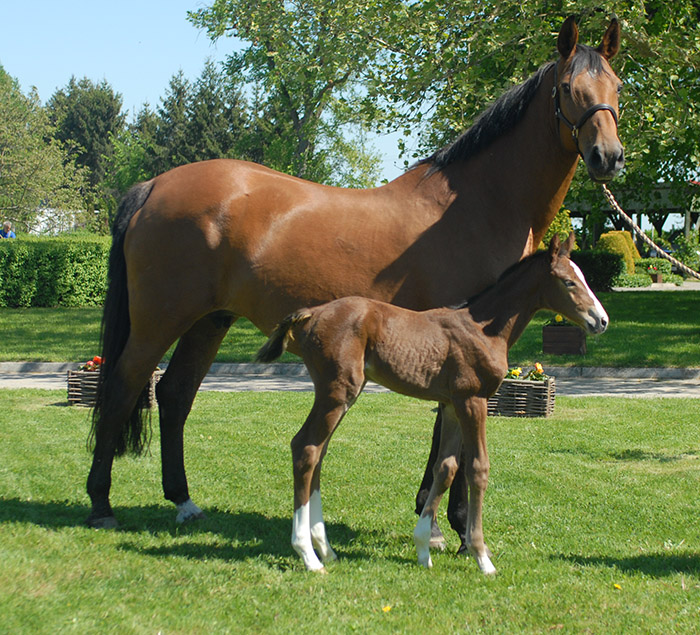
L-Rovina with a foal by Favoritas xx
The move to Poland came about because Malgorzata Siergiej wanted to own a Ramiro mare, any Ramiro mare. Malgorzata recalls: “We bought her when she was 12, because I wanted to own a Ramiro mare, this was for me really important. It didn’t matter to me from what Stamm she came. One year later I bought her daughter by Quinar. During the first years I have only used Holsteiner stallions. Diarado was the spectacular winner of the selection in Neumünster. I tried to use different stallions for her to find the best cross, after few years I decided to use only stallions with blood. We register L-Rovinia’S offspring with the Oldenburger Verband, she produced several fillies by the stallions, Spartacus, Clarimo, Favoritas xx and For Pleasure. Rovinia’s son Diamiro (Diarado) is approved for Mecklenburg Vorpommern. We wanted to present him at the Oldenburger Verband approvals but during his stay there he got injured. I took him back home and after two days he was ok again. Now I am the owner of two of her daughters, by For Pleasure and Favoritas xx, and a colt by Quickly de Kreisker.” Diamiro is currently competing at 1m40 under the saddle of Kama Godek.
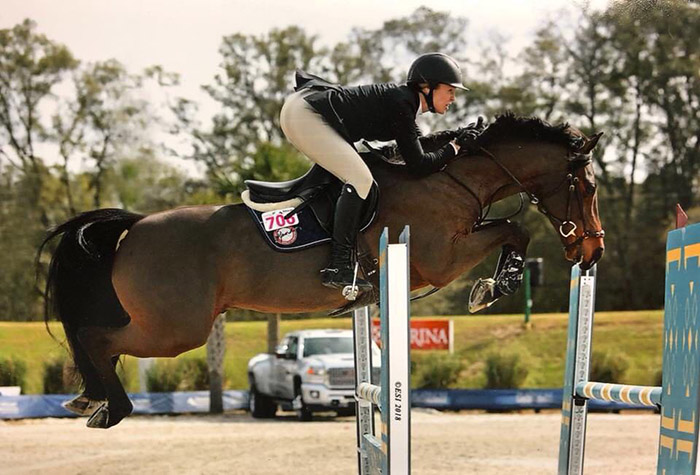
Diamiro with Kama Godek
Maibirke
A filly out of Carena’s grand-daughter Herietta, Maibirke was sold to Nord Friesland, a region in northern Holstein, to Ernst Guenter Nagel from Löwenstedt. His son Jens Bernard Nagel rode her in 1m20 classes. She was an unbelievable healthy and strong mare according to people who knew her. She was then sold to Peter Carl Petersen, he recalls: “Maibirke was a real Marlon xx daughter and she had a lot of temperament, I liked Caretino (Caletto II – Isidor x Metellus, Stamm 826, bred by Lothar Völz). Their product Dolli II was a once in a life time mare, her character was very kind. Children could play with her foals and bury them under straw and Dolli II would watch them calmly. Her offspring were very different, some had the character of Dolli II and some from their grandmother Maibirke. I have chosen five times breeding her to Cassini I because as a young horse he had impressed me a lot.”
I visited Maibirke’s Caretino daughter Dolli II in 2006. She was a beautiful mare with a colt by Colman (Carthago – Rosenquarz x Lord, Stamm 223B, bred by Klaus Meyn) by foot. Dolli’s first five offspring were all by Cassini I. First Dolli II produced two daughters; Hannah I and Inken I.
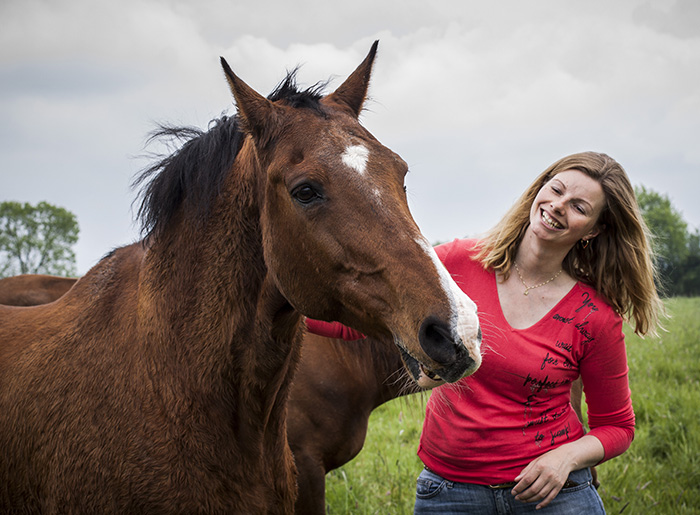
Adriana meets Hannah…
Hannah I used to be owned by Arnaud Dobber, he also owned Charmander (full brother to Hannah I and Inken I). Hannah I jumped at 1.40 level with Jörg Carstensen. For Arnaud Dobber she produced four offspring, Action Dream Z (Action Hero) is competing with Dana Tourville and Charambo (Carambo) who is jumping at 1m40 with John Thomas Russell. Hannah I is now owned by Eric Levallois, he says: “I bought Hannah I, in my stable her name is Claire, about seven years ago. I really wanted to have a mare by Cassini I. She had a history of becoming not easy in foal. I guess I can say now that I am really lucky, because I have two mares and four colts out of her. Five by Diamant de Semilly because I think he crosses really well with Cassini I mares and one by Untouchable. In the beginning I knew nothing about her mother line, but I have learned in the last few years that it is a very good line. Theo Molenaers showed me at the last stallion approvals in France a lot of videos of close relatives. My hope for this year is to have two daughters of Claire at the National Young Horse Championships in Fontainebleau.”
The second mare was Inken I and the third Cassini I offspring is Calisco JMEN who was sold to Brazil. According to Thomas Petersen (he had most of the Cassini I offspring from Dolli II as young horses in his stable) Calisco JMEN seemed to be the best sport horse and he has built up a name as a breeding stallion at Haras Agromen.
Charmander is the fourth Cassini I offspring. In 2003 Charmander placed third at the Bundeschampionat for 5 year old jumping horses and in 2004 as a six year old he placed second at the Bundeschampionat. Both times ridden by Olympic Gold Medalist Ulrich Kirchhoff. Later they jumped at 1.50 level. Charmander is also Holsteiner Verband approved, but he had to be castrated due to an inflammation in his testicles. At the present Charmander is 19 and is still competing with his owner Kim Beattie at lower level, she says: “Sometimes something comes into your life, so unexpectedly takes your heart by surprise, and changes your life forever. When I met Charmander in Ocala 2014, I was looking for another jumper. Time went by, more horses were tried & nothing could compare. Every time, when Charmander enters the show ring, whether the jump is 2’ or 4’3”, he thinks he is back in the Grand Prix. At being 20 years old in May, he still feels and acts like he is 5. I call him my unicorn, he does whatever I ask, takes me wherever I want to go and always tries to win. He is undoubtedly my horse of a lifetime, no other horses compare, which makes it very hard when I need new ones!”
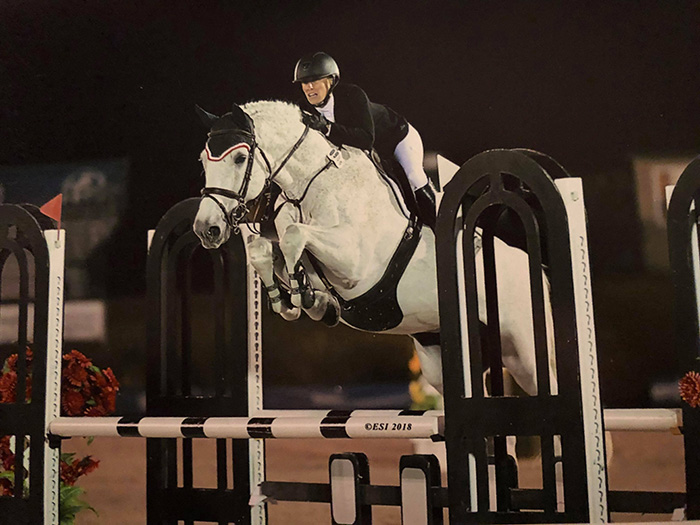
Charmander and Kim Beattie
The fifth Cassini I, Clooney, jumped also at 1.40 level. The rider of Clooney, Soenke Kohrock recalls: “Clooney has the character like you would want a horse to have. He jumps with fantastic jumping skills; careful and has scope. As a young horse he always had good results. As a six year old he was sold to an amateur who was placed with him up to 1.35 level and I started him at 1.40 level. At his first S show we were placed right away. He is a horse that everybody would like to have to jump at S level or to offer for sale.”
Dolli II also produced the 1m40 jumping horse Curacao 24 (Carlos DZ) under the saddle of Jasmin Zielinski.
Inken I
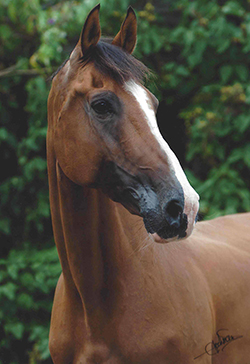
Inken I is very special to her owner Theo Molenaers, he recalls; “I bought Inken as a three year old. Norbert Boley from the Holsteiner Verband told me I should see her. Her breeder, Peter Carl Petersen brought her to the stable of Thomas Petersen and I liked her right away. She was in foal to Littorio, this was going to be Ninken. Looking back at the 20 years that I have owned her, I can say that she is for me a ‘horse of a life time’. I would really like to thank Thomas Petersen and Norbert Boley for finding her and that I could buy her.”
Inken I was as a three year old champion of the mare approvals in the Region Nord Friesland and was qualified for the Elite Mare show in Elmshorn. Peter Carl Petersen says: “I did not want to sell Inken. She was a very beautiful horse and her jumping was really good, already when she was 2.5 years old I received offers to buy her, but I said no until it was not wise anymore to keep her.”
Jörg Carstensen rode Inken I as a young horse, he recalls: “She was a dream to ride and received for her mare test a 10 for free jumping. Inken I was already as a young horse a very special mare.”
She was sold to Theo Molenaers from Belgium (in foal with Ninken). In 1998 she produced Ninken (Littorio) as a four-year-old. Ninken was only to produce one offspring, the approved Holsteiner stallion Clicksem (Cardino). Ninken was sold to the USA and died unfortunately soon after arriving there.
After her first foal Inken started her sports career in Belgium with success, she was competing for two years under saddle of Philippe Vandelanoitte, he recalls: “Inken I was an outstanding mare to ride. She had an unbelievable willingness to perform, was very careful and intelligent.”
At her best she competed at 1m55 level with American international, Peter Wylde:
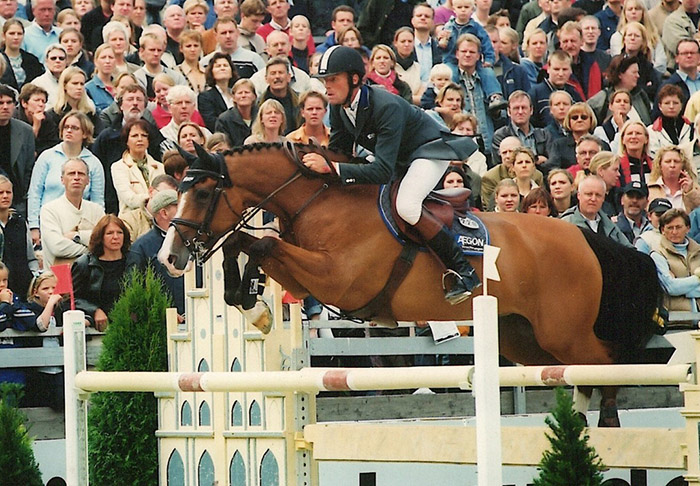
“I rode her for two years. She was extremely careful and very sweet. She was injured after I have ridden her and Theo Molenaers decided to breed with her. She’d had a foal earlier that was good, so he decided he would just breed with her. So far, she has produced some incredible jumpers. I really have to say that Inken had ultra-quality, she had unbelievable quality. I think that Theo was really interested in breeding and so that is why she finished her sports career right after the injury, but she was an unbelievable jumper! I never got that far with her to test if she could jump 1m60, we jumped a couple of 1m50 classes and maybe a 1m55 class if I remember right. Inken was always very careful and we go so high. The most important thing was that she had so much quality and I think that she was also super determined. She was a very positive mare, but not a kicker or anything like that. I would have imagined that if she got older and more experienced that she would have jumped the big classes for sure. I think that if you were clever about your breeding you would use her for breeding and that is exactly what Theo did.”
Hikari Yoshizawa has ridden since 2011 for Theo Molenaers. Currently she has five horses that are out of Inken I under saddle: Cascass (Casall), Cassinka (Cassaro), Dinka (Diarado), Quinka (Quintero) and her grandson, Clicksem out of Ninken by Cardino. She says: “They are all quite different for me, but what they have in common is their very sweet character and their willingness to work. Also I believe that they are very careful and have a very good technique for jumping. They are quite hot, so maybe in the beginning they need bit more time. It is after some point unbelievable how much they want to learn and want to try their best for you. They all have so much quality!!”
At the moment four offspring of Inken I are jumping at 1m40 and higher level: Dinka, Quinka (1m45-1m50), Quinken and Incaro LS (Carusso LS la Silla) . Her grandson Clicksem has already competed at 1m55.
The oldest offspring from Inken is Quinken (Quintero) who has a show record of jumping at 1m40 level. Theo Molenaers says about her offspring: “They all jump unbelievable with a good technique and scope. They need time before they are fully grown up and they have a good character. One year older than both Diarado’s is a nine-year-old Quintero mare. She looks almost like a Thoroughbred, very noble and elegant. I used Quintero (Quantum – Ibara x Chamonix, Stamm 569, bred by Joachim Ahsbahs) for Inken I because I thought it would be a good combination and Rolf Göran Bengtsson was riding him at the time. I used Cassaro for Inken I because I would keep a longer frame in type and he was upcoming with Janne Frederieke Meyer. All Inken I’s offspring are very careful so I don’t need to worry about that when I look for a stallion. Inken I had in 2013 a filly by Riscal la Silla, I knew this stallion very well and I thought his intrinsic values as a jumping horse, top rideability and willingness to perform, would fit very well with Inken I. Her last foal was also a filly by Adagio de Talma.”
Theo continues about Inken I: “Inken I herself is a beautiful long lined mare with a long neck and a lot of presence. She was a dream to work with, she has an outstanding character. I remember really well that at least seven or eight years ago when my daughter who was six year old decided she wanted to ride her. Inken had already spent quite some years here in the field to have a career as broodmare, suddenly my daughter wanted to sit on her and after her riding career nobody had sat on her again. I put a leadrope on and put my daughter on her back and we were walking around in the field. The other horses were bucking around and being crazy but Inken never took a wrong step and when I took my daughter off and let her go she continued bucking through the field. It says everything about the mare. She is enjoying her retirement from breeding and jumping with me at home. ”
Dinken
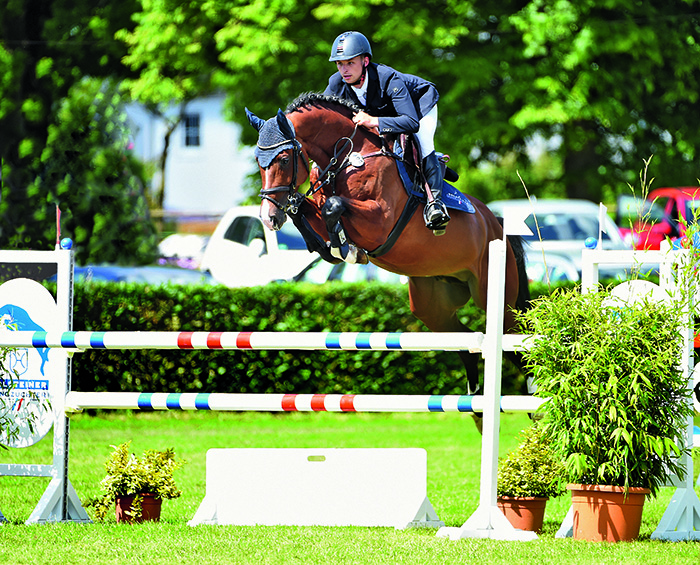
This brings me to Inken’s eight-year old-son Dinken (Diarado). He was a sensation in 2012 at the Holsteiner approvals, not only because of his jumping but also because he was so excited by the atmosphere and audience that people were scared that he would jump into the audience. He got away from his handler Uwe Benzin by standing on his foot (and Uwe’s foot was broken) and made his own show for some minutes in the Holstenhalle. This produced a lot of negative chatter amongst the breeders.
I have spoken with Uwe Benzin and he said Dinken doesn’t have a bad character at all, but he was clearly excited by everything that was going on in the Holstenhalle in Neumünster. The stallions are two years old when they go to the approvals and that is a major challenge for them.
He became a premium stallion at the approvals. He performed really well at the 30 day test with a 9 for his jumping ability. Thomas Konle who used to ride the Verband stallions had high hopes for Dinken: “He shows a great technique and willingness to go over the fence.”
In June 2014, he was shown in the 4-year-old class at the Elmshorn State Championship under Thomas Konle. It was his first public outing, but he performed very smoothly, scored 8.6 and placed second. Gerard Muffels told me that Dinken covered in his first year between 90 and 100 mares and in his second year again around 100 mares. That is a lot for a young stallion especially in a time like this when stallions have a hard time to get any mares.
Particularly impressive was the quality of Dinken’s first foal crop in the summer of 2014: energetic, with excellent type and tremendous movement.
Steinburg district’s winning filly foal was a Dinken daughter.
Dinken won the State Championship of the six year old jumping horses in 2016 under saddle of Jonas Panje. Dinken has so far four approved sons. He showed the characteristics that are known for this line, a great rideability and his willingness to perform.
Theo Molenaers says about Dinken and Dinka: “I used Diarado (Diamant de Semilly – Roxette I x Corrado I, Stamm 318D2, bred by Klaus Thingholm Kristensen) for Inken I because I think that he is an excellent jumping horse and he comes from a very good motherline. Also Diarado brings horses with a good mind and who have a really good rideability. Dinken’s full sister looks really good and is a very modern build mare with a lot of expression. I am really fond of this line.”
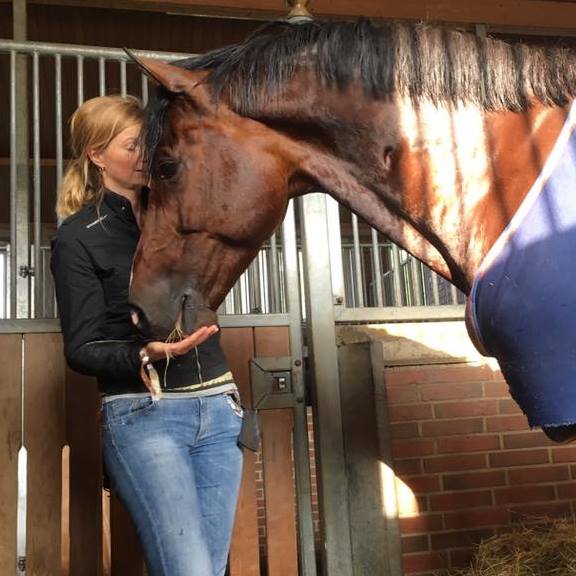
Clicksem
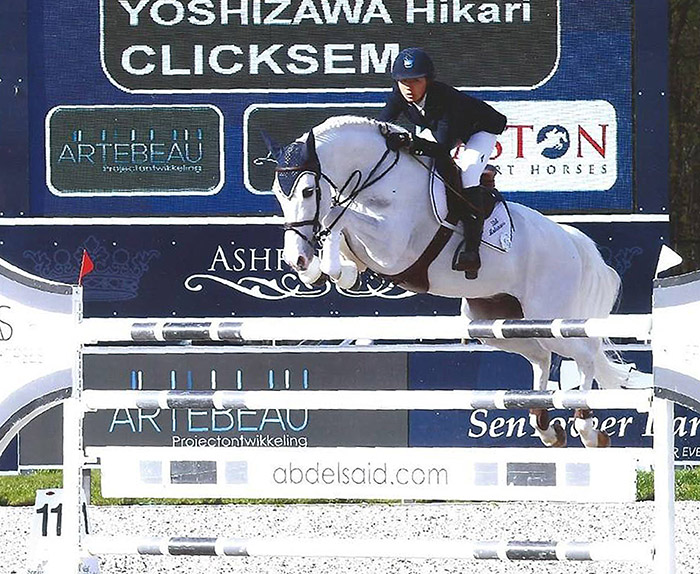
Inken’s daughter Ninken would only produce one foal.
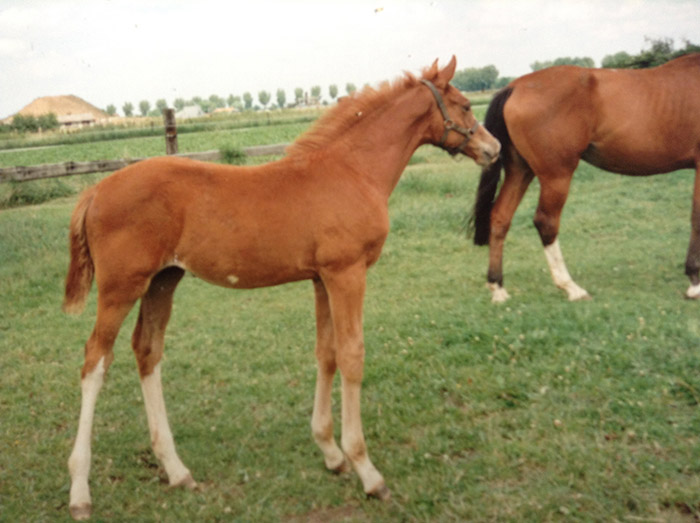
Ninken as foal
As a four year old she became mother to the Holsteiner stallion Clicksem (Cardino), who was approved in 2011 for the Holsteiner Verband. Ninken started her sporting career under the saddle of Philippe Vandelannoitte slowly. When she was seven she did some shows in France. Philippe recalls: “Ninken was very careful and had a perfect way of jumping. Her mother Inken I was easier with the scope. Both Ninken and Inken I had a very good canter. They also have both a very good character.”
Theo Molenaers says about the stallion choice of Cardino: “Cardino looked like he was a really nice horse, he was jumping at 1m40. He was young enough and looked very promising. He had a super rideability and willingness to perform. Ninken had a lot in common with her mother, she had a lot of blood and was a great horse to work with. She jumped very easily with Philippe at 1m35. I really regret it that I sold her, she would have been a really valuable mare.”
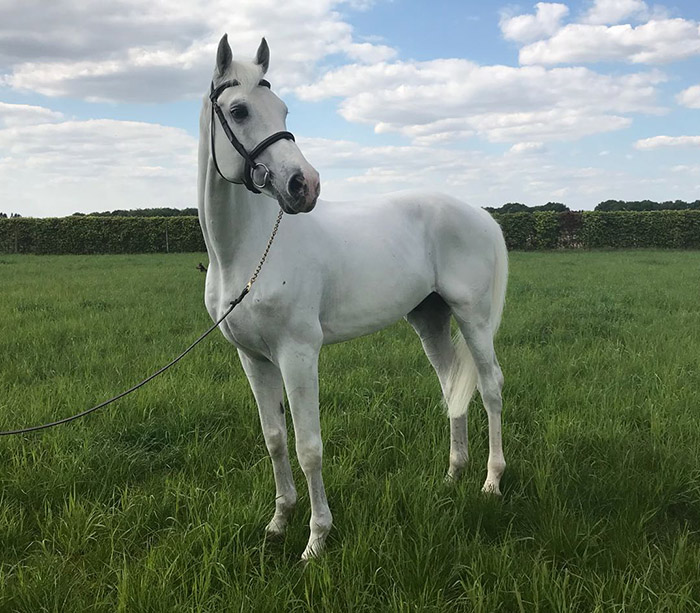
Clicksem was seven years old when Florian Meyer zu Hartum started to ride him, he rode him for two years and he recalls: “Clicksem always made it easy for me as a rider. It was every day a real pleasure to work with him, because he has an amazing rideability and is very intelligent. Also in the course he was always very focused and careful.”
His current rider Hikari Yoshizawa says: “I started to ride Clicksem as a nine year old, he already jumped at 1m50 with Florian Meyer zu Hartum. His character is amazing, he is always happy to work and jump, it doesn’t matter at home or on the show. He always jumps each fence with his super technique! He has an amazing rideability, he has an unbelievable willingness to perform and what I also very much like about him is his balance. I have done with him some CSI3* GP which is 1m50/1m55 level and he always gives his everything to try to make a clear round for me!!!”
Eric Levallois said once ‘breeding is for dreamers’ and I agree for the most part. I still dream of owning a filly out of this family! Thunderstorms play a role in my journey with this family. Once I had to go through a thunderstorm on my bicycle to see Josiane giving birth and last year I drove from sunny Deauville in Normandy to a thunderstorm and horrible weather in Kinrooi, Belgium… I drove 60 km with aquaplaning and stayed 45 minutes under a rooftop with Inken I in her field because I was too scared to run back to my car that I parked right in front of the gate.
I was the first person that saw Josiane’s son, Acodetto after he was born. I made him dry because Josiane was too tired to get up. He has a wonderful owner in Normandy, France. I was the one that made the choice of using Cardento for Josiane. When this colt was born I have tied up his afterbirth and spent quite some time that year in the field with Josiane and Gasparone. Not knowing it would be the last year that Josiane would be healthy and alive. Gasparone is seven and is competing in showjumping in Italy.
Josiane was for me the horse of a life time!! It was my dream to see at least one Holsteiner approved stallion from this line, now there are three. When I visited Dolli II, 12 years ago, I knew she was special. Other breeders laughed and thought I was crazy. Clicksem was at that moment only four years old and Dinken wasn’t even born yet. Both Cicksem and Dinken will pass on the character with the blood, intelligence and rideability that is known for the horses from Stamm 2294. Plus with their offspring they will make sure Stamm 2294 will continue!
Clicksem has his own Facebook page to inform breeders and other interested people about his results in sport and about his offspring and family.




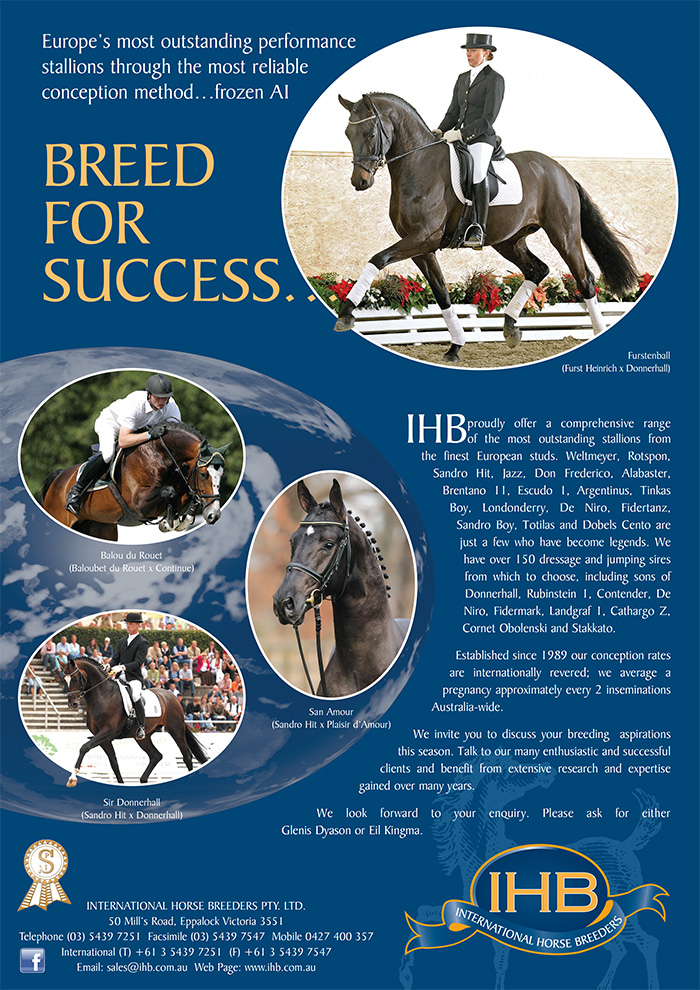
Great article Adriana !! Very interesting to read about Dreams family.